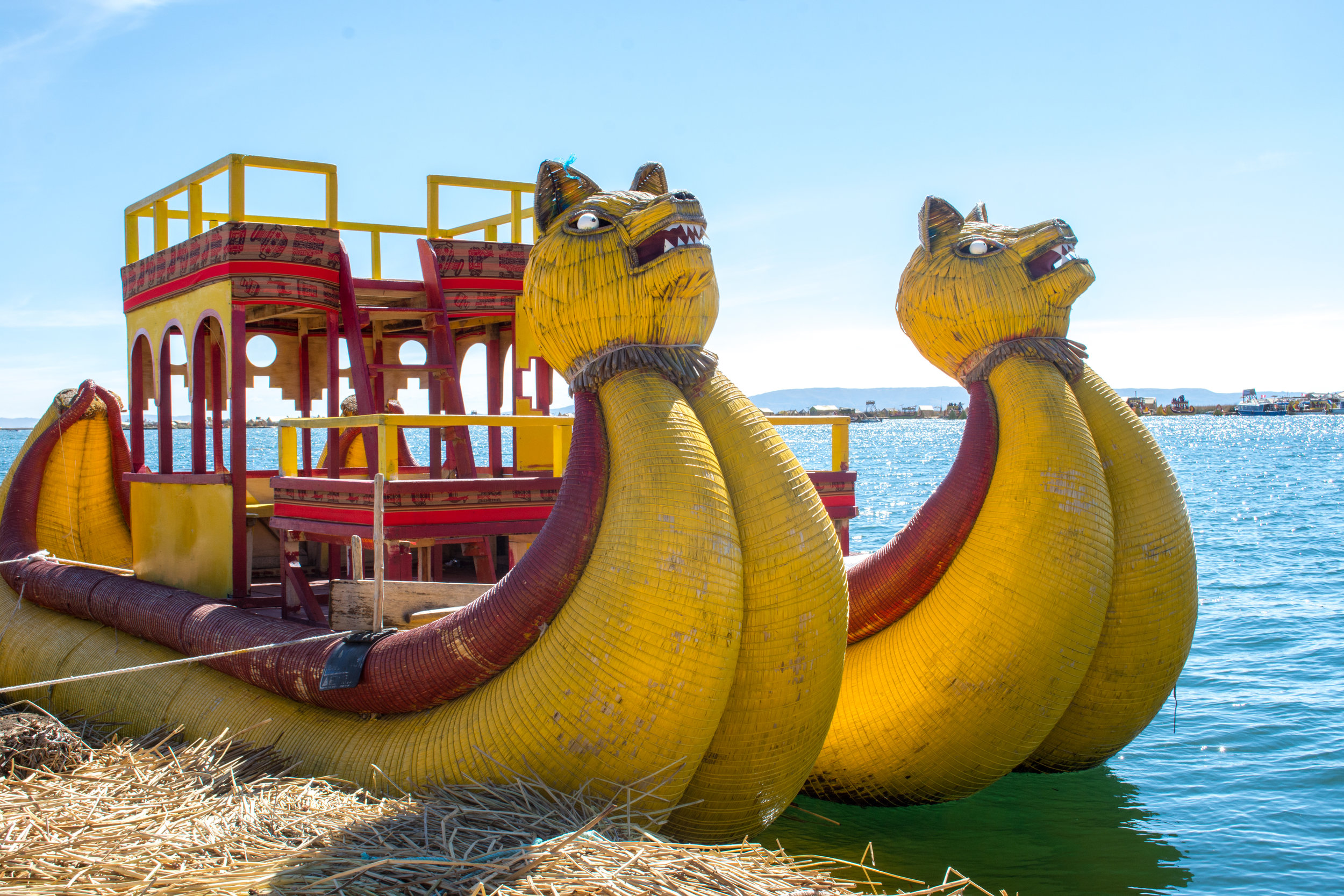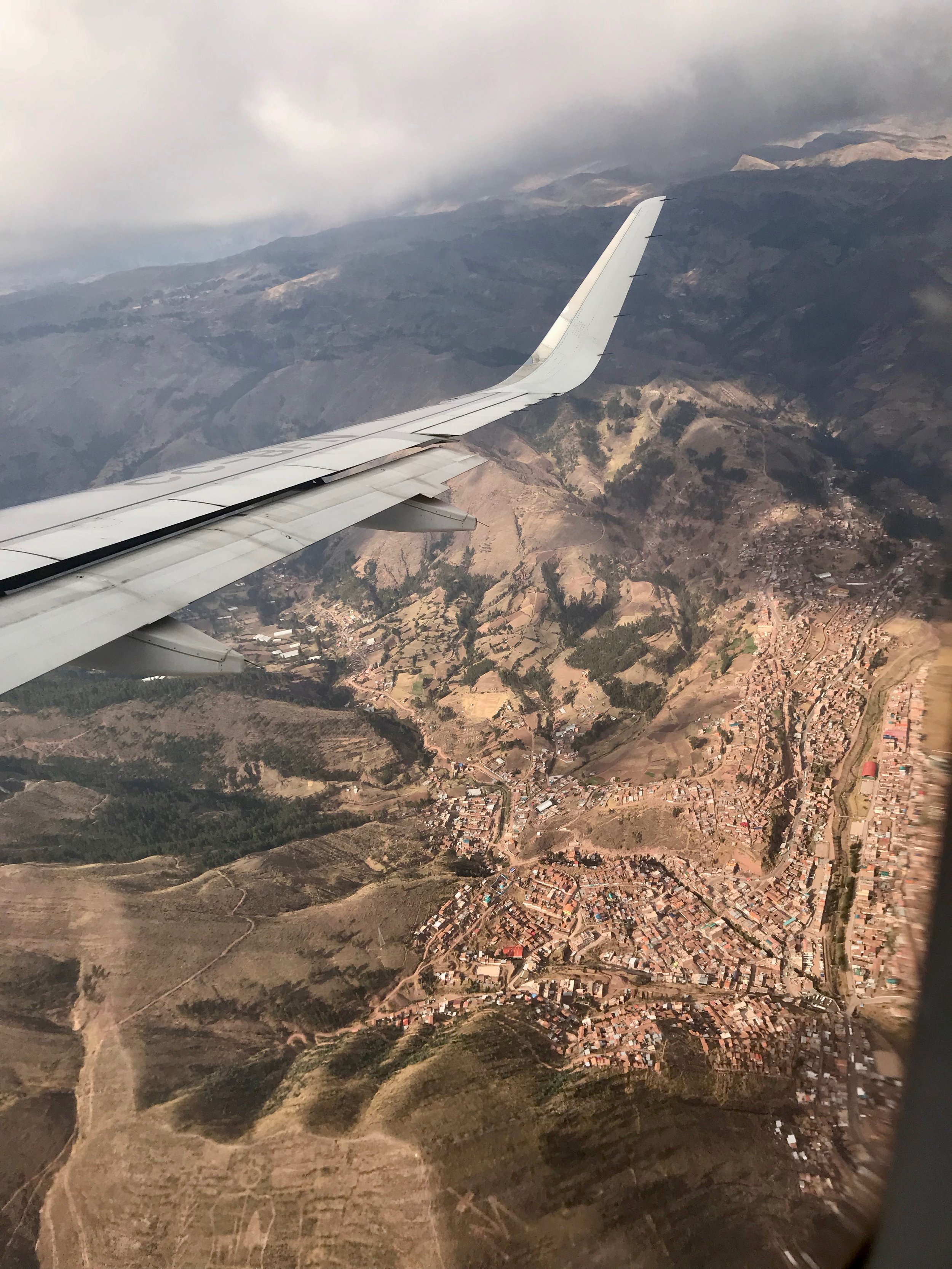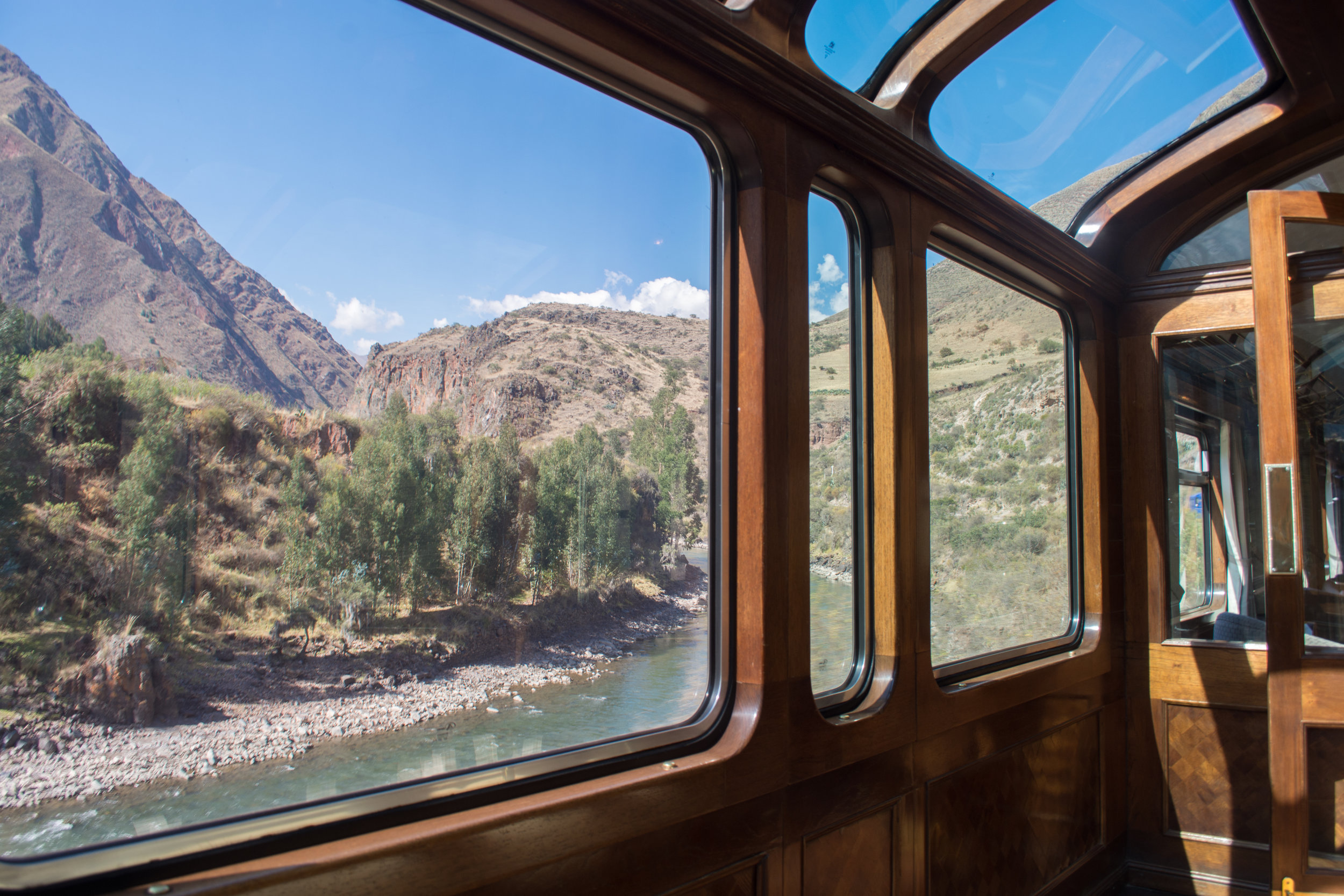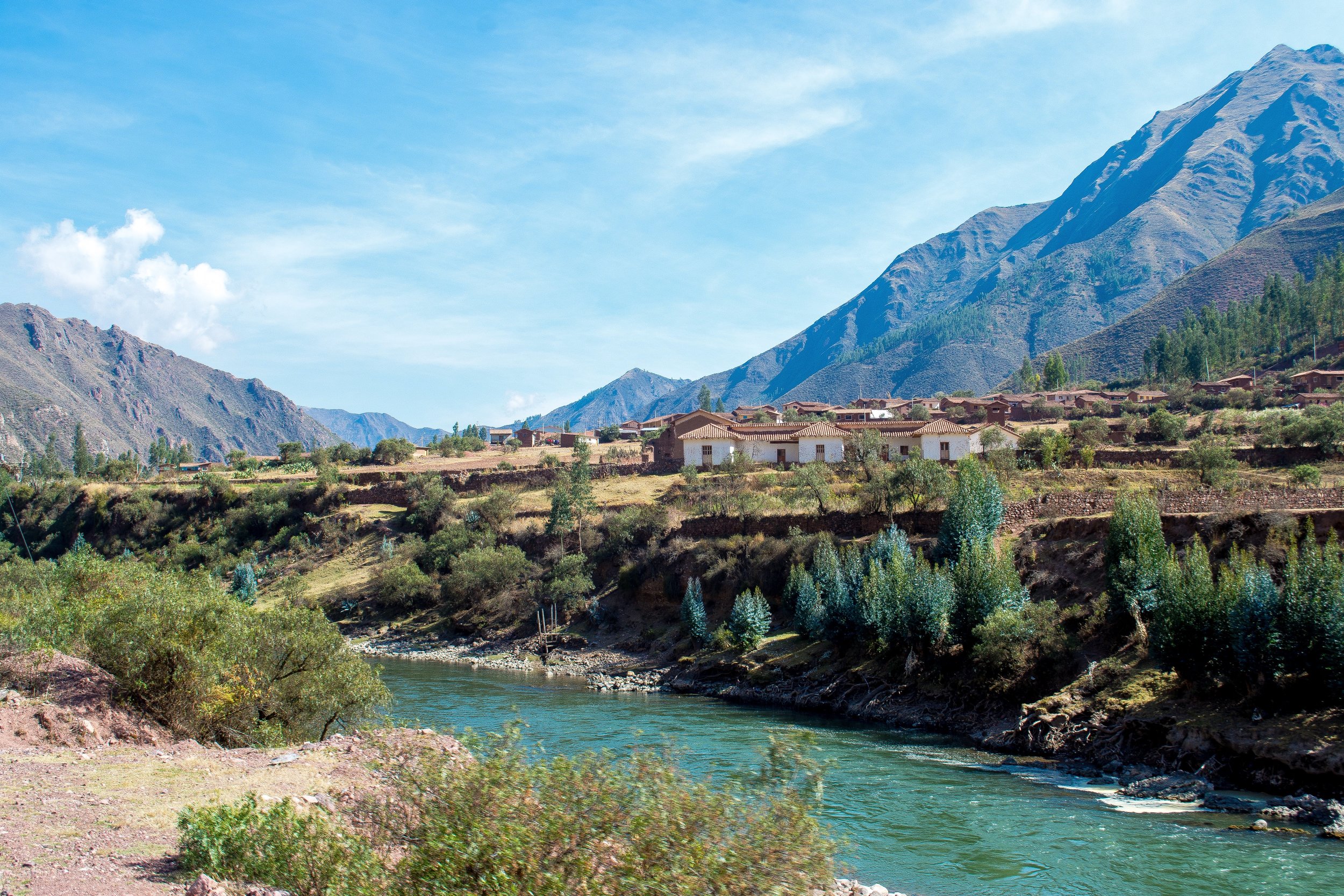Best Way to Get from Cusco to Puno, Peru
THIS POST MAY CONTAIN AFFILIATE LINKS. WHEN YOU CLICK ON THESE LINKS WE RECEIVE COMPENSATION, AT NO EXPENSE TO YOU, THAT HELPS THIS BLOG RUN. ALL OPINIONS ARE OUR OWN.
Going from the Sacred Valley to Lake Titicaca (or vice versa) is a common route for most travelers in Peru. Puno is the gateway to the Peruvian side of Lake Titicaca, the highest navigable lake in the world. With car travel often discouraged in Peru, it is often difficult to figure out the best way to travel across the country. Here we outline the different ways to get between Cusco and Puno and each ones’ benefits.
Boat from the Floating Islands of Uros in Lake Titicaca
There are three options for how to get from Cusco to Puno:
Each has their own advantages. The best way to travel between Cusco and Puno is ultimately dependent on how you like to travel and your priorities. Here we will examine each option by several factors:
Duration
Plane: 3.5 hours (1-hour flight, 1.5 hours waiting at the airport, 1-hour taxi)
Train: 10 hours
Bus: 10 hours
The plane can get you there in a third of the time. The closest airport to Puno is in the nearby city of Juliaca. You will need to get a 1-hour taxi from the airport to Puno. Depending on how early you like to get to the airport, you will be able to get from the center of Cusco to center of Puno in 2.5 to 4 hours. Both the tourist bus and train are estimated to take around 10 hours. The bus includes a few extended stops, but the train only has 1 10-minute stop. If you want to get to Puno has fast as possible, then:
Winner: Plane
City of Cusco from the plane
Andes Mountains from the plane
P.S. There isn’t too much to do in Puno, beside Lake Titicaca. Since most of the Lake Titicaca boats leave early in the morning, if you take a plane, plan to spend the other half of the day in Cusco rather than Puno.
Read our post on the 11 Things to Do in Cusco, Peru
Experience
Plane
A plane ride is a plane ride. While this flight is unique for being at such high altitude, if you have already flown into Cusco, it is a similar experience. Both the Juliaca and Cusco airports are above 11,000ft of elevation. The surroundings of the Cusco airports are beautiful mountains, but the area around Juliaca is mostly flat. All in all, it will be similar to any other plane ride you’ve been on – except for a longer runway.
Since the flight is so short it does not come with a meal and likely will not come with complimentary drink service. Both the Cusco and Juliaca airports are small with limited food options. If you have priority pass access, we were surprised to find out that Juliaca does have a decent lounge, especially for just being a 2-gate airport.
Train
The PeruRail Titicaca Train is a luxury 1920s-style Pullman train. Think Orient Express. Romantic and slow travel at its best. Part of the fun comes from the train itself. This is not like a normal commuter train you are used to back at home. It has 2 dining cars, a bar car, and an observation car at the back. Throughout the journey, they have traditional Peruvian singers and dancers giving shows in the bar car. However, you are free to do whatever you wish with the 10-hours on the train. Stay in your seat in the dining car reading a book, gaze at the views in the open-air observation car, or enjoy drinks and music in the bar car.
They serve 2 gourmet meals (lunch and afternoon tea) that are included in the price, and optional breakfast for an additional cost. The train makes one stop, half-way through at La Raya. The stop is only about 10 minutes. There is a small church and a local textile market.
Bus
The most popular way to get to Puno is by bus. The tourist bus is a coach bus, occasionally a double-decker. You get to choose your seats in advance. Typically there is no wifi or TVs on the bus. The tourist buses do make several cultural stops on the way, totaling a couple of hours. One of the stops being La Raya, the same stop as the train. The other stops are at 2 chapels/temples and a museum. They also make a stop for a buffet lunch, that is included in the price. At each stop, a guide from the bus talks through each sight. The guide also provides information while on the bus.
Stop at La Raya
Small Chapel at La Raya
If you are into guided tours of smaller and less-visited cultural sights, the bus might win for the experience. However, personally, I’d give it to:
Winner: Train
Views
The advantage of traveling slower are the views. Both the train and bus go along a similar route through the Andes. Most of the train journey is right in the middle of the stunning Urubamba river valley, with the second half through specular pastures. It is known for being one of the most scenic train rides in the world, and definitely the most scenic in Peru. The bus’s route is a bit off to the side of the train’s. There are a couple times they cross or go alongside each other for a bit.
Views from the Train
While the bus has similar beautiful views, it does come with a big caveat. The inability to take unobstructed photos. The open back observation car of the train allows you to take clear photos from all sides along the entire journey. On the bus, you would have to take photos through the smudgy glass and only on the side that you are seated on. Furthermore, while the route is similar, the train track is in a far more scenic part of the valley than the road.
View of Urubamba River from the Train
Juliaca Market
The train also goes right in the middle of both small villages and large cities. You see locals enjoying everyday life right by the train tracks. In Juliaca, there is a massive varied market that is right on the train tracks. Fruit is placed between the tracks so they don’t have to be moved when the train goes by.
The plane has some pretty decent views, especially near Cusco, but no comparison to traveling on the ground through the Andes.
Winner: Train
Comfort
Dining Car on Train
The popular internal Peruvian airlines (LATAM, Avianca) are reasonably comfortable. By taking a plane, you are also only confined to a moving object for an hour rather than 10. The bus, as well, has nice seats grouped in twos. There is a relatively clean bathroom (at least at the start of the journey) at the back of the bus. Depending on the season you visit, the bus isn’t always properly temperature controlled. The few stops, allow you to get up and stretch your legs and break up the 10-hour transfer.
The train has large, cushioned old-fashioned seats that are rather comfy. You are grouped at a table with your party or by yourself if you are traveling solo, meaning no awkward staring across at strangers. You are also free to roam along the train the entire time. The only time they ask for you to be seated in the dining car is while they are serving you food, obviously. There are multiple areas to sit or stand. The train is a tiny bit rattly, but it is not too much of a challenge to walk. The bathrooms are exquisitely decorated in the same style as the rest of the train, stocked with fancy moisturizers and hand soap. There is a cleaner that spends the whole time going back and forth along the train, wiping down the doors, windows, and cleaning the bathrooms. Being a luxury train, there are many staff members there to make sure you are satisfied.
Winner: Train
Price
Plane: $120 ($5 taxi to Cusco Airport, $90 foreigner price for flight, $25 taxi from Juliaca to Puno)
Train: $240
Bus: $60
The train is by far the most expensive, at 2x the price of the flight and 4x the price of the bus. Additionally, the bus (as with the train) includes the price of lunch. Price of the plane also includes the necessary transfer costs to get to/from the airports. The hour taxi from Juliaca to Puno will usually cost you around $25. Those taxi costs will be split if traveling in a group. The train and bus drop you off in the middle of a very walkable city, so a Taxi probably isn’t necessary. The winner is quite clearly:
Winner: Bus
View and Observation Car on the Titicaca Train
So What is the Best Option?
It depends on what you value. Are you a budget traveler through and through? Take the Bus. Are you uneasy about spending 10 hours on a moving vehicle? Then fly. Are you able to spend a bit extra for comfort and incredible views? Reward yourself with the Train.
I am a bit of a sucker for train travel. I love the slow pace of it. Traveling in an old romantic Pullman car was a bucket list experience, only made better by the impressive views. However, the price is a deterrent for many travelers. If you cannot afford it, don’t exceed your budget by $240 for just one day’s adventures.
Once you are in Puno, you have to leave by some means. It is not worthwhile to take the same method, no matter where you are going next. If you are taking the train or tourist bus to Puno, it is foolish to take it back to Cusco – you will be seeing all of the same stuff. If you took the plane to Puno and are planning to go to Cusco by plane as well, you will be missing all of the incredible highland scenery. We were traveling to Lima after Puno, so we took the plane (as it would be 22 hours of travel by bus) on our way out of Puno.
Taquile Island
Cusco Cathedral
Alternative options
Welp, call me a liar. I started off by saying there are three options, but in reality, there are a few more.
You can self-drive your way to Puno, along the same road as the bus. Without the stops the bus makes, the drive will probably take 7 hours. This is only for the adventurous. The standards for driving in Peru are lower than most of the rest of the world. The drivers are prone to speeding, some crazing overtaking on mountain bends, ignoring lane divisions, etc. Also, depending on your full itinerary, the fees for a one-way car rental may make driving more expensive than both the bus and flying. Driving does allow you to stop wherever you want. If you would prefer not to drive yourself, but still have the option to stop anywhere, you can hire a private car and driver.
Instead of taking the tourist bus, you could take the public/local bus to Puno. This will be cheaper than the tourist bus, but you get what you get what you pay for. The local buses are iffy on the condition. These buses will not make the touristy stops. You may get a bus without a toilet, uncomfortable cramped seats, foul smells, etc. Head to the bus station in Cusco to see when the next bus is departing. If you don’t speak Spanish, this option might be a bit tricky. You should expect to pay just $8 a person.
And this last option is the most expensive of them all: the sleeper Belmond Andean Explorer Train. This luxury train has individual rooms for the guests, with full beds and bathrooms. The rest of the train consists of a spa car, a lounge car, an observation car, and dining cars. It is an overnight train, with options that span multiple days and multiple destinations (complete with pre-arranged excursions). The shortest itinerary is just one-day and one-night, ending in Puno in the morning. For the cheapest room (bunk-beds), it costs $1410 for one night for 2 people.
Let us know in the comments, which option you will take.























